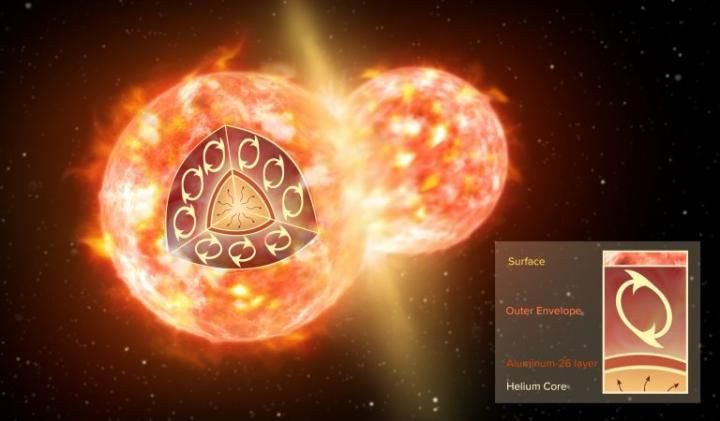First-Ever Radioactive Molecule Spotted Around Remains Of Two Collided Stars

More than three centuries after detecting a massive collision between two stars, an international team of astronomers has found the remnant of the event, a bright nova, is surrounded by an extremely rare radioactive molecule.
The material, known as 26-aluminum monofluoride or 26AIF, bears unstable radioisotope of aluminum (26AI) and is first-of-its-kind to be directly observed in space.
"The first solid detection of this kind of radioactive molecule is an important milestone in our exploration of the cool molecular universe," Tomasz Kamiński, the lead researcher behind the discovery said in a statement.
Scientists have long known about the presence of this molecule in the universe. Previous studies had posited our Milky Way itself hosts some three solar masses worth of 26AI, but there was no direct evidence for its presence until international group used Atacama Large Millimeter/submillimeter Array and the Northern Extended Millimeter Array to study the remains of this merger.

First detected all the way back in 1670, the merger appeared as a bright, red nova some 2,300 light years away from Earth. It was visible to the naked for a few years but eventually faded away in the darkness of the cosmos. Today, only sophisticated telescopes can see the remnant of the stellar collision, which is now called CK Vulpeculae or CK Vul.
CK Vul, as researchers described, currently looks like a dim central star shrouded by a halo of free-flowing material. This debris hosts a range of molecules, including the radioactive ones detected by the team.
For years, scientists have known molecules in space can be detected by the unique spectral signature of the millimeter-wavelength light they emit. In this case, the team determined the characteristic fingerprint of 26AIF molecules and used that information to identify the radioactive material around CK Vul.
The discovery provided critical insight into the stellar merger and helped the team posit that the two colliding stars were not too heavy. One, as they said, is likely to be a red giant weighing as much as 1 to 2.5 suns’.
More importantly, the work also showcased that a sun-like star’s deep inner layers, where radioactive isotopes are believed to have formed, can be blasted into space as a result of stellar collisions like the one seen in space.
"We are observing the guts of a star torn apart three centuries ago by a collision," Kamiński added. "How cool is that?"
That said, it is worth noting the team believes stellar collisions like this aren’t the only source of three sun’s mass worth of 26AI in the Milky Way. These events are extremely rare and the amount of radioactive molecule noted in CK Vul — nearly a quarter of Pluto’s mass — clearly suggests there is more of it, waiting to be discovered. However, as the telescopes involved in this work can only detect 26Al with fluorine, they also stressed on the possibility the amount of radioactive version of aluminum could be much greater than currently thought.
The study titled, “Astronomical detection of radioactive molecule 26AlF in the remnant of an ancient explosion,” was published July 30 in the journal Nature Astronomy.
© Copyright IBTimes 2024. All rights reserved.





















